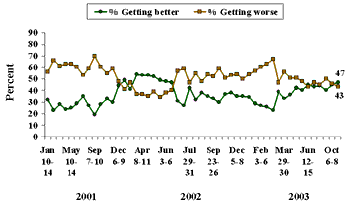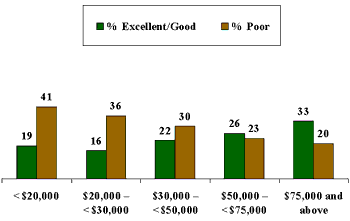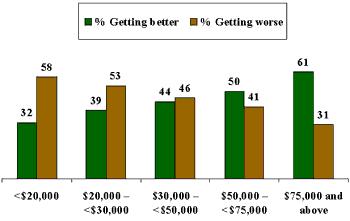GALLUP NEWS SERVICE
The U.S. Commerce Department reported Thursday that the economy grew at its fastest pace in nearly two decades -- an annual rate of 7.2% -- during the third quarter. In sharp contrast, Gallup Poll economic data collected in late October show more consumers continue to rate the economy as "poor" than rate it as "good" or "excellent."
Of course, this does not mean that consumer optimism didn't improve at all in October. While less than half (47%) of Americans say that current economic conditions are "getting better," this is a higher percentage than have said so at any time since June 2002. Combined, consumer responses to these two key questions suggest that Americans are more hopeful that the economy is improving, but so far they haven't seen much real economic improvement actually taking place.
These public perceptions seem to be well aligned with those of the Federal Open Market Committee (FOMC), which left interest rates unchanged at its meeting Tuesday. An FOMC statement explained part of the rationale behind its decision: "The Committee perceives that the upside and downside risks to the attainment of sustainable (economic) growth over the next few quarters are roughly equal." The FOMC added that recent evidence confirms that spending is firming, and the labor market appears to be stabilizing.
So why aren't the FOMC and consumers as a whole more optimistic as the economy surges ahead? More importantly, why is consumer spending soaring while consumer optimism is not doing likewise? A look at consumer optimism by income provides some interesting insights.
A Slight Improvement in Current Economic Conditions
In late October, more consumers continue to say current economic conditions are "poor" (30%) than say they are "good" or "excellent" (26%) -- a difference of -4 percentage points. This is virtually the same as in early October, when the difference was -5 percentage points (27% "poor" minus 22% "good" or "excellent"). The October ratings represent a slight improvement from the -9 percentage-point difference in September, when 30% of consumers rated current economic conditions as poor and 21% rated them good or excellent. On the other hand, the October ratings remain below those of August, when the differential was +2 percentage points with 25% of consumers rating current economic conditions as good or excellent and 23% rating them as poor.
Currently, consumer perceptions of the economy are just about where they were late last December, when the difference was also -4 percentage points. In fact, consumer perceptions of the current economy were actually somewhat better a year ago (Oct. 31-Nov. 3), when the difference was +2 percentage points.
| Rating of Current Economic Conditions |
 |
More Optimism of the Economic Direction
In late October, more consumers say economic conditions are "getting better" (47%) than say they are getting worse (43%) -- a difference of +4 percentage points. This means consumers are more optimistic about the future prospects for the U.S. economy than they were in early October, when the difference was a -1, and significantly more optimistic than they were in September, when the difference was -10 percentage points. Still, even as the economy surges, the percentage of Americans saying they think economic conditions are getting better rather than worse remains below the 50% mark reached during March, April, and May of 2002.
| Economic Conditions Getting Better or Getting Worse? |
 |
Higher-Income Consumers Rate Economic Conditions Much Better
While consumers overall do not seem properly enthusiastic about the current economic expansion, this is not the case across all consumer income groups. One in three consumers making $75,000 or more annually rate current economic conditions as good or excellent, while only 20% rate them as poor -- a difference of +13 percentage points. In sharp contrast, 41% of consumers with annual incomes of less than $20,000 rate current economic conditions as poor, while only 19% rate them as excellent or good -- a difference of -22 percentage points. Consumer ratings of the economy improve significantly as income increases across the income distribution.
| Rating of Current Economic Conditions: By Income Group |
 |
| Oct 6-8, 2003 & Oct 24-26, 2003 |
Higher-Income Consumers Are Much More Optimistic
While consumers overall remain less optimistic about the direction of the economy than they were a year ago, this also is not the case across all consumer income groups. Six in 10 consumers with annual incomes of $75,000 or more say economic conditions are getting better, while only 31% say they are getting worse -- a difference of +30 percentage points. In sharp contrast, 58% of consumers with annual incomes of less than $20,000 say economic conditions are getting worse, while 32% say they are getting better -- a difference of -26 percentage points. Consumer optimism about the future direction of the economy also increases significantly as income increases across the income distribution.
| Economic Conditions Getting Better or Getting Worse? By Income Group |
 |
| Oct 6-8, 2003 & Oct 24-26, 2003 |
Income Differences May Explain a Lot
It is not surprising that higher-income consumers are much more optimistic about the economy than their lower-income counterparts are. Higher-income consumers benefit more from home equity and stock market gains than do lower-income people. Because these kinds of gains have fueled the current economic recovery, higher-income consumers are seeing their economic well-being improve and expect this to continue as the economy expands.
Overall consumer confidence data do not reveal that there is a significant percentage of the population that has become very optimistic as the economy is surging. As a result, measures of overall consumer optimism hide what is really taking place and make it look as though consumer confidence is not highly related to improving economic activity. By hiding the surge in optimism among higher-income consumers, the overall averages also make it seem as though consumer confidence does not affect consumer spending. However, when it is recognized that higher-income consumers are becoming very optimistic, then it makes sense that their spending is increasing. Therefore, it is surging confidence among higher-income consumers -- the ones who have real discretionary income -- that is driving consumer spending higher.
At the same time, it is not surprising that lower-income consumers are much less optimistic than their higher-income counterparts are. These are the people most directly affected by the lack of job growth during the current economic expansion. They are the ones most significantly affected by job compression and unemployment. And, they are least likely to benefit from today's productivity gains, home equity gains, and stock market gains.
In sum, Gallup's economic data suggest that it is not the consumer confidence data that no longer relate to consumer spending and economic growth, but the fact that we have not been focusing on the surge in higher-income consumer confidence that has been misleading. More importantly, Gallup's consumer confidence data by income suggest that as long as the home equity and stock market gains continue, higher-income consumers are likely to keep spending and the economy is likely to continue expanding at a good pace even as the job market languishes. The only real question is whether this kind of scenario is acceptable to the public as a whole and thus maintainable.
Survey Methods
Results are based on telephone interviews with 1,017 national adults, aged 18 and older, conducted Oct. 6-8, 2003, and 1,006 interviews with national adults conducted Oct. 24-26, 2003. For results based on these total samples, one can say with 95% confidence that the margin of sampling error is ±3 percentage points. Data from both October polls are combined to provide consumer confidence by income.

